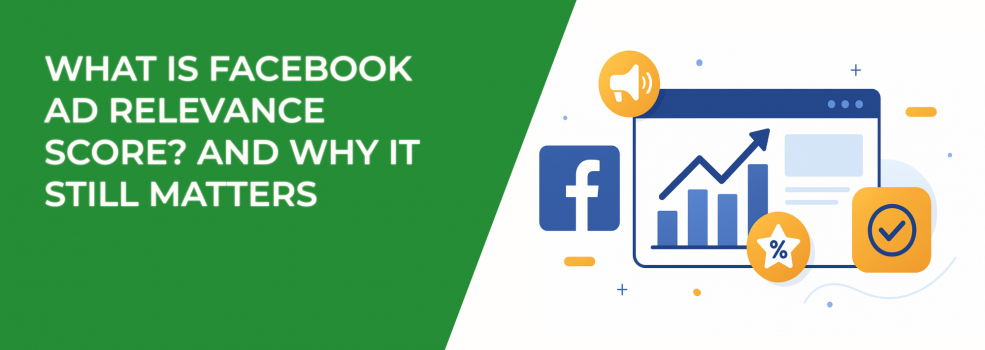If you’ve ever run a Facebook ad campaign, you’ve probably noticed one small but important number tucked away in your dashboard — the Facebook Ad Relevance Score. At first glance, it may look like just another metric in a sea of data. But if you want your ads to perform better and cost less, this score is worth paying attention to.
So what exactly is it, and why does it still matter for advertisers today? Let’s break it down.
Understanding Facebook Ad Relevance Score
Facebook introduced the Ad Relevance Score to give advertisers a snapshot of how well their ads resonate with their audience. The score typically ranges from 1 to 10, with higher numbers meaning your ad is more relevant to the people seeing it.
Think of it as Facebook’s way of grading your ad. If people interact positively — clicking, liking, commenting, or watching your video longer — the score goes up. If they hide the ad, ignore it, or mark it as irrelevant, the score drops.
In short, the relevance score helps answer a simple question: Is your audience actually interested in what you’re showing them?
Why Relevance Score Still Matters
Although Facebook has since replaced the single Ad Relevance Score with more detailed “Relevance Diagnostics,” the concept hasn’t lost its weight. Advertisers still need to understand how relevance directly impacts cost, reach, and campaign effectiveness.
Here’s why it continues to matter:
-
Cost Efficiency – Ads with higher relevance tend to enjoy lower CPM (cost per thousand impressions). Facebook rewards advertisers for delivering quality content.
-
Better Reach – The platform wants users to see ads they care about. Relevant ads often get more impressions because the algorithm favors them.
-
User Experience – A high score signals that your ad doesn’t feel disruptive. Instead, it blends into the user’s feed in a way that adds value.
Ask yourself this: if two advertisers are targeting the same audience, who will win more attention — the one with a generic message or the one with a finely tuned, engaging ad?
If you’re digging into how Meta evaluates ads today, read our breakdown of the Quality, Engagement, and Conversion Rate rankings for practical thresholds and fixes.
How to Improve Your Ad Relevance
Boosting your Facebook Ad Relevance Score doesn’t happen overnight. It’s the result of thoughtful planning, creative testing, and ongoing optimization. Let’s dig deeper into the key ways you can increase ad relevance and make your campaigns work harder for you.
1. Nail Your Targeting
The most engaging ad in the world will flop if it’s shown to the wrong people. Start by narrowing your audience:
-
Use Custom Audiences to retarget people who’ve already interacted with your business (website visitors, past buyers, email subscribers).
-
Experiment with Lookalike Audiences to reach new users who resemble your best customers.
-
Don’t ignore interest-based targeting — combine multiple interests for a more defined audience instead of going too broad.
When your ad is placed in front of people who are already primed to care, your relevance score naturally climbs.
Still debating scope? This explainer weighs retargeting vs broad strategies across budgets and learning phases.
2. Refine Your Creative
Creativity is the first impression your ad makes. But “creative” doesn’t just mean flashy visuals — it’s about crafting a message that resonates.
-
Use bold, high-quality images or short videos that pop in the feed.
-
Write copy that speaks directly to the audience’s pain points and desires.
-
Keep the text concise, but don’t be afraid to add a touch of storytelling to spark curiosity.
Ask yourself: Would I stop scrolling for this ad? If the answer is no, your target audience probably won’t either.
To stop the scroll faster, borrow a few psychological hooks that nudge attention without resorting to clickbait.
3. Test Different Variations (A/B Testing)
Even seasoned advertisers are often surprised by what works best. A slight change in wording, a different color button, or a new video format can dramatically shift performance.
-
Split-test your ad headlines.
-
Try different calls-to-action (“Sign Up Today” vs. “Start Learning Now”).
-
Compare static images with video ads to see which drives more clicks.
The data you collect tells you what your audience values most — and that insight is pure gold for future campaigns.
Structure experiments with smart creative testing so each variant answers a single, useful question.
4. Match Message with Offer
Relevance drops the moment expectations aren’t met. If your ad promises a free guide, don’t send people to a generic homepage. If you’re advertising a discount, highlight it clearly on your landing page.
-
Align your headline with the landing page copy.
-
Keep your visual theme consistent across ads and website.
-
Deliver exactly what you promise, without extra steps that frustrate users.
This alignment builds trust, reduces bounce rates, and sends positive signals back to Facebook.
5. Monitor Engagement Signals
Your audience’s behavior determines your score. Every click, comment, share, or video completion improves ad relevance. Negative interactions (hides, reports, skips) pull it down.
-
Track key metrics in Ads Manager weekly.
-
Adjust targeting if engagement is low — it may mean your audience is too broad.
-
Refresh your creative regularly to avoid “ad fatigue.”
Think of engagement as the clearest vote of confidence. The more people interact positively, the more Facebook rewards you with lower costs and broader reach.
If quality signals wobble, use this primer on engagement metrics that matter to prioritize fixes that lower costs.
6. Use Strong Social Proof
People trust other people. Ads featuring testimonials, star ratings, or customer stories often see better relevance. Why? Because they reduce skepticism.
-
Add a short customer quote to your creative.
-
Highlight user-generated content when possible.
-
Showcase credibility badges or trust signals if relevant.
Authenticity is hard to fake, and your audience can tell when something feels real.
Want authentic visuals that convert? Tap UGC workflows here — UGC for authenticity — and boost relevance in crowded feeds.
7. Keep Mobile in Mind
Most Facebook users are scrolling on their phones. If your ad isn’t optimized for mobile, you risk losing attention instantly.
-
Use vertical or square video formats that fill the screen.
-
Keep text large enough to read at a glance.
-
Make sure landing pages load fast and look good on smaller screens.
Even the best creative won’t work if people can’t easily view or act on it.
The takeaway? Improving ad relevance is about aligning three things: the right audience, the right message, and the right experience. When those pieces work together, your Facebook Ad Relevance Score improves — and so does your bottom line.
Real-World Example
Imagine you’re running ads for an online course. One version shows a generic stock photo with text like “Learn Faster, Earn More.” Another version uses a real instructor, a short testimonial, and a clear headline about what students will gain.
Which ad do you think would earn a higher relevance score?
The second one, of course — because it feels authentic, addresses a real need, and connects emotionally. That’s the difference between an ad that just takes up space and one that actually delivers results.
Final Thoughts
Facebook Ad Relevance Score may have evolved into new metrics, but the principle behind it remains powerful: ads that resonate perform better. If you keep your audience in mind, fine-tune your creative, and pay attention to engagement signals, your campaigns will naturally cost less and achieve more.
At the end of the day, every advertiser wants more efficient campaigns and happier customers. Understanding relevance is one of the simplest — yet most overlooked — ways to get there.

